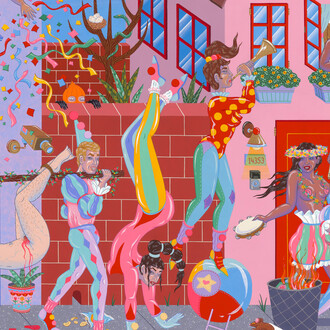Painting is an artform which finds its existence questioned more than any other - first declared dead almost two centuries ago by Paul Delaroche after seeing daguerreotype photographs for the first time. In spite of this, artists continue to produce paintings and viewers continue to look at them, in search of the ways in which the medium is capable of helping us to see beyond the implied certainty of the image.
In fact, it’s this dialogue with which The lightness of being is concerned - what exactly painting does for an image. The illusory surface of the painting creates an opportunity for an image to be understood (or misunderstood) to a greater extent than it otherwise could have been, the object and subject of the painting exist in harmony with one another. The painting essentially acts as a mediator between reality and the interpretation of the viewer, in essence, what the image feels like is expanded beyond anything else.
In this new series of paintings, and his first presentation with Nicodim, Tomas Harker creates an opportunity for the viewer to become entangled with the barrier between the self and everything else. Engaged deeply with historic and contemporary dialogues in painting, these new works employ a sophisticated understanding of the relationship between medium and subject, building subtle narratives through bold decisions in the application of color, texture and composition. The slick, often disarming, surfaces are capable of drawing the viewer into a dialogue, presenting perspectives in subtle strokes, shifting under the skin, employing the familiar and the unfamiliar, not juxtaposed but simultaneous, in the process of mapping Harker’s undefinable conceptual landscape.
The source image from Persona is a still extracted from Cracked actor (the 1975 documentary on David Bowie) in which the musician dons a transparent mask, a literal mediator between the person and the character. By wearing the mask (adopting a character, a persona) Bowie is able to better communicate the performance to his audience, the meaning becomes more clear by removing part of its attachment to a corporeal reality.
The act of painting, as well as the material, is the mediator between reality and belief. It describes an idea, an image, a feeling without having to curtail itself within the boundaries of existence, instead able to float in the ether of perspective. These new works perform as veils, concealing the transient nature of being, leaning into a warm and comforting conceit in which reality is pacified.
(Text by Allan Gardner)
Tomas Harker (b. 1990, United Kingdom) lives and works in London. His works addresses the nature of meaning in conditions of mediated experience and hyperreal saturation. Harker’s practice often draws from a variety of image production and distribution systems in an attempt to make sense of a cosmic order becoming increasingly disordered. His paintings reflect the increasing murkiness and confusion of contemporary life, whilst remaining mindful of the dynamics of power benefiting from uncertainty. Exhibitions include Multiple choice fairytale ending, The Sunday Painter, London (2023, solo); New ancients, Guts Gallery, London (2023); The artist is present, Guts Gallery, London (2022); Apotrope, Cob Gallery, London (2022); I haven’t been sleeping, Screw Gallery, Leeds (2021, solo); Bloomberg new contemporaries, South London Gallery, London (2021); Third nature, Copeland Gallery, London (2021, solo); A sea in suspense, Bo.lee Gallery, London (2019, solo); There’s something about painting, Tatjana Pieters, Ghent (2019); Cite, Bo.lee gallery, London (2018); Syzygy, Leeds Arts University, Leeds (2018).
















